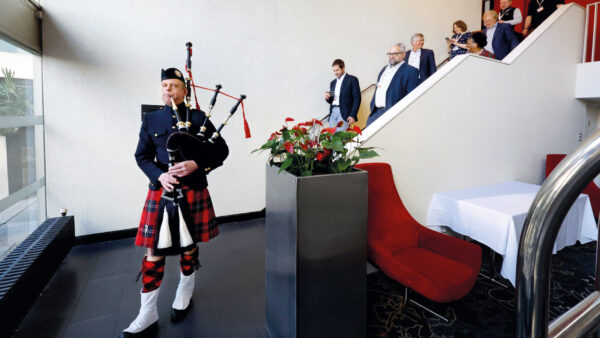
Lack of attention to firestopping can have devasting consequences. In this article, Craig Wells, sales director at Quelfire, discusses how it can be improved through early engagement and standardised processes
Since the tragedy of the Grenfell Tower, many positive changes have been happening in the industry, including more emphasis on the way firestopping is delivered – and with greater emphasis on service penetration sealing and early engagement.
A service penetration seal is a passive fire protection system intended to maintain the fire resistance of a compartment wall or floor where services – such as cables, pipes or ventilation ducts – go through it.
The traditional approach to service penetration sealing was to construct a building, create the apertures and run all the services through before initiating contact with the firestopping contractor.
However, the industry is now entering into design and build contracts which require early engagement, attention to detail and collaboration. For these concepts to be successful, an element of cultural change is required.
Firestopping of Service Penetrations: Best practice in design and installation is a guide jointly published by Association for Specialist Fire Protection (ASFP), BSRIA, Building Engineering Services Association (BESA), Finishes and Interiors Sector (FIS) and Gypsum Products Development Association (GPDA). In it there are nine golden rules. Seven of these relate to the building’s design. Golden rule one relates to issuing early engagement with firestopping manufacturers and specialist installers.
What is early engagement?
Procurement has traditionally been carried out in the order of the procurement value of each package. This means service penetration sealing was not considered until several months into a project. But, as high-rise building fires have demonstrated, this is far too late – with sealing around services penetration found wanting.
Early engagement aims to involve all key stakeholders to ensure service penetration sealing considerations are addressed and integrated into the project’s design phase, rather than being an afterthought.
Follow the golden rules
1: Ensure early engagement with firestopping manufacturers and installers.
2: Review fire strategy documents and plans with M&E specifications.
3: Identify service types and establish the space required.
4: Follow the design process for penetration seals.
5: Select products that are third-party certified by a UKAS-accredited organisation.
6: Ideally select products from one manufacturer throughout the project.
7: Request copies of third-party certification from manufacturers.
8: Ensure installers are third-party certified by FIRAS, LPCB, IFC etc.
9: Implement an inspection plan with photographic evidence.
Golden rules in full: https://quelfire.co.uk/knowledge-advice/what-is-the-best-practice-guide
When it comes to service penetration seals, many trades are directly involved. For a typical formed opening, otherwise known as a letterbox application, there will be drylining and mechanical and electrical contractors as well as other specialist installers: sprinkler; ventilation; and electrical contractors among others. The final responsibility lies with the firestopping contractor to seal the service penetrations.
All these parties need to be engaged because products must be installed as per the tested scope of application. Aspects such as positioning of services, types of services and insulations and sizing of letterboxes affect the efficiency of the product or system. Golden rule four states: “Follow the design process for penetration seals.”
Firestopping solutions are typically selected by the main contractor, which has the responsibility to ensure the chosen solutions are compliant and installed accordingly. Many external trades need to be involved, making it a complex process, so implementing a standardised design process for each project is highly recommended.
What is involved in Quelfire’s recommended process?
1. Identifying the requirements
The starting point for all parties is understanding the project’s wants and needs. The fire strategy requirements, such as required fire ratings and, to some extent, the location of fire-rated walls and floors, are likely to be non-negotiable. Other factors – such as the choice of services, any required insulation or even the type of wall or floor construction – should be project desirables at this stage.
However, the success of early engagement depends on all parties’ flexibility. For instance, if there are no available tested solutions for the type of insulation or service desired, compromise is crucial to identify alternative tested solutions. These grey areas must be rectified at an early stage.
Once the project’s specifications have been identified – including the types of pipes, cables, dampers, insulation and walls and floors – the next step is to decide how services should penetrate the wall or floor.
2. Engaging with the relevant parties
When the requirements have been identified, the designer should engage with the appropriate firestopping manufacturer to identify the available tested solutions. Once there is a portfolio of details, the designer can gather all information into one design and communicate it to the supply chain.
This part of the process is paramount in incorporating the tested scope of application and ensuring that all the relevant, competent trades are happy with the design and can practically and efficiently build it.
In the event that any untested applications come to light, it becomes necessary to start the process from the beginning, identifying any changes that need to be made.
3. Preparing to build
At this point, there will be a finalised design. This will clearly outline each service’s precise service penetration sealing solutions, including spacing requirements. Once the details have been approved and everyone agrees, construction can commence. This enables installers on site to adhere to the provided design guaranteeing that installations meet compliance requirements. l
This article is based on a PSJ webinar, Firestopping Best Practice: Engage early, with Craig Wells, sales director at Quelfire, and Graeme Whitty, national product director at Willmott Dixon.
What are the benefits of implementing early engagement and standardised processes?
Details are tested
Initiating early engagement increases flexibility when designing services. This flexibility makes it easier to choose a solution based on what has already been tested.
When no tested solution exists, but the application frequently occurs on site, manufacturers can conduct a fire test if they are aware of the emerging trends.
It is in manufacturers’ interest to test common occurrences, but testing and certification are time-consuming. Hence, they must be notified as soon as possible.
It saves lives
The ultimate reason firestopping needs to be compliant is to save lives. In the case of a fire outbreak, there should be a high level of confidence that service penetration seals will work as they are supposed to.
From a tender perspective, once all parties agree on and understand the design, the risk is mitigated, providing peace of mind.
It helps avoid extra costs and delays
To ensure buildings are safe and comply with relevant regulations, firestopping needs to be designed according to the manufacturers’ tested details.
Where firestopping is not considered when decisions are made about the location of compartmentation walls and central routes of M&E services, there is no guarantee that the manufacturer will have a tested solution.
If these discrepancies come to light too late in the project, stakeholders can face extra costs and delays due to redesigning service penetrations.
It ensures compliant and achievable installations
Considering service penetration sealing at the early stages will also facilitate work at the installation stage.
It allows more time for parties to utilise the support offered by the manufacturer and prepare installation work by training onsite labour and arranging procurement of the correct firestopping products as in the design.
Improved reputation
Firestopping is a complex matter, needing coordination between several trades.
A clear and structured plan will safeguard a company’s reputation and give it a competitive advantage, through eliminating concerns about non-compliance amid increased scrutiny following the Grenfell tragedy and subsequent changes to legislation.
Graeme Whitty, national product director at Willmott Dixon, in a recent webinar, emphasises that the contractor’s business decision to prioritise what it builds, how it builds it and the products it uses is crucial.
This choice enables the business to provide customers with confidence in meeting their needs, complying with regulations, and ensuring performance throughout the building’s life cycle.












